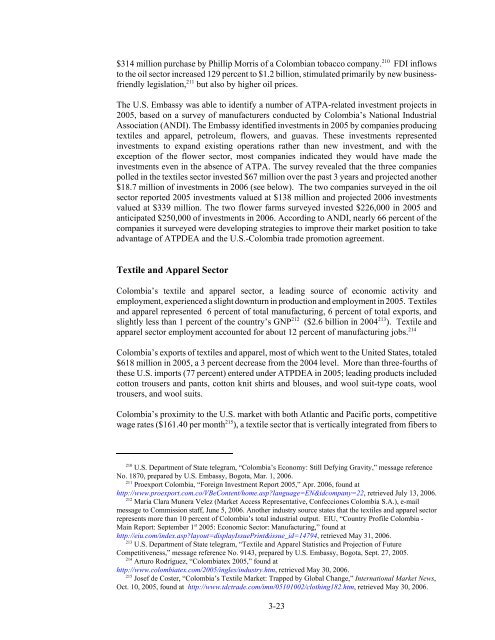The Impact of the Andean Trade Preference Act Twelfth ... - USITC
The Impact of the Andean Trade Preference Act Twelfth ... - USITC
The Impact of the Andean Trade Preference Act Twelfth ... - USITC
- No tags were found...
Create successful ePaper yourself
Turn your PDF publications into a flip-book with our unique Google optimized e-Paper software.
$314 million purchase by Phillip Morris <strong>of</strong> a Colombian tobacco company. 210 FDI inflowsto <strong>the</strong> oil sector increased 129 percent to $1.2 billion, stimulated primarily by new businessfriendlylegislation, 211 but also by higher oil prices.<strong>The</strong> U.S. Embassy was able to identify a number <strong>of</strong> ATPA-related investment projects in2005, based on a survey <strong>of</strong> manufacturers conducted by Colombia’s National IndustrialAssociation (ANDI). <strong>The</strong> Embassy identified investments in 2005 by companies producingtextiles and apparel, petroleum, flowers, and guavas. <strong>The</strong>se investments representedinvestments to expand existing operations ra<strong>the</strong>r than new investment, and with <strong>the</strong>exception <strong>of</strong> <strong>the</strong> flower sector, most companies indicated <strong>the</strong>y would have made <strong>the</strong>investments even in <strong>the</strong> absence <strong>of</strong> ATPA. <strong>The</strong> survey revealed that <strong>the</strong> three companiespolled in <strong>the</strong> textiles sector invested $67 million over <strong>the</strong> past 3 years and projected ano<strong>the</strong>r$18.7 million <strong>of</strong> investments in 2006 (see below). <strong>The</strong> two companies surveyed in <strong>the</strong> oilsector reported 2005 investments valued at $138 million and projected 2006 investmentsvalued at $339 million. <strong>The</strong> two flower farms surveyed invested $226,000 in 2005 andanticipated $250,000 <strong>of</strong> investments in 2006. According to ANDI, nearly 66 percent <strong>of</strong> <strong>the</strong>companies it surveyed were developing strategies to improve <strong>the</strong>ir market position to takeadvantage <strong>of</strong> ATPDEA and <strong>the</strong> U.S.-Colombia trade promotion agreement.Textile and Apparel SectorColombia’s textile and apparel sector, a leading source <strong>of</strong> economic activity andemployment, experienced a slight downturn in production and employment in 2005. Textilesand apparel represented 6 percent <strong>of</strong> total manufacturing, 6 percent <strong>of</strong> total exports, andslightly less than 1 percent <strong>of</strong> <strong>the</strong> country’s GNP 212 ($2.6 billion in 2004 213 ). Textile andapparel sector employment accounted for about 12 percent <strong>of</strong> manufacturing jobs. 214Colombia’s exports <strong>of</strong> textiles and apparel, most <strong>of</strong> which went to <strong>the</strong> United States, totaled$618 million in 2005, a 3 percent decrease from <strong>the</strong> 2004 level. More than three-fourths <strong>of</strong><strong>the</strong>se U.S. imports (77 percent) entered under ATPDEA in 2005; leading products includedcotton trousers and pants, cotton knit shirts and blouses, and wool suit-type coats, wooltrousers, and wool suits.Colombia’s proximity to <strong>the</strong> U.S. market with both Atlantic and Pacific ports, competitivewage rates ($161.40 per month 215 ), a textile sector that is vertically integrated from fibers to210 U.S. Department <strong>of</strong> State telegram, “Colombia’s Economy: Still Defying Gravity,” message referenceNo. 1870, prepared by U.S. Embassy, Bogota, Mar. 1, 2006.211Proexport Colombia, “Foreign Investment Report 2005,” Apr. 2006, found athttp://www.proexport.com.co/VBeContent/home.asp?language=EN&idcompany=22, retrieved July 13, 2006.212Maria Clara Munera Velez (Market Access Representative, Confecciones Colombia S.A.), e-mailmessage to Commission staff, June 5, 2006. Ano<strong>the</strong>r industry source states that <strong>the</strong> textiles and apparel sectorrepresents more than 10 percent <strong>of</strong> Colombia’s total industrial output. EIU, “Country Pr<strong>of</strong>ile Colombia -Main Report: September 1 st 2005: Economic Sector: Manufacturing,” found athttp://eiu.com/index.asp?layout=displayIssuePrint&issue_id=14794, retrieved May 31, 2006.213 U.S. Department <strong>of</strong> State telegram, “Textile and Apparel Statistics and Projection <strong>of</strong> FutureCompetitiveness,” message reference No. 9143, prepared by U.S. Embassy, Bogota, Sept. 27, 2005.214Arturo Rodríguez, “Colombiatex 2005,” found athttp://www.colombiatex.com/2005/ingles/industry.htm, retrieved May 30, 2006.215Josef de Coster, “Colombia’s Textile Market: Trapped by Global Change,” International Market News,Oct. 10, 2005, found at http://www.tdctrade.com/imn/05101002/clothing182.htm, retrieved May 30, 2006.3-23
















